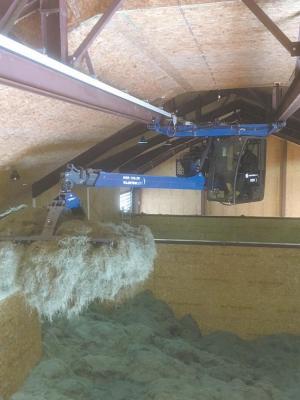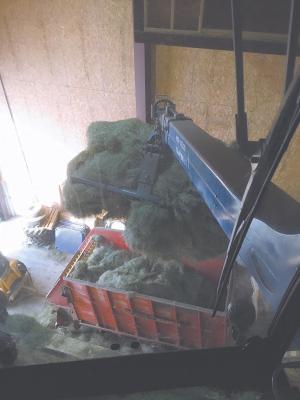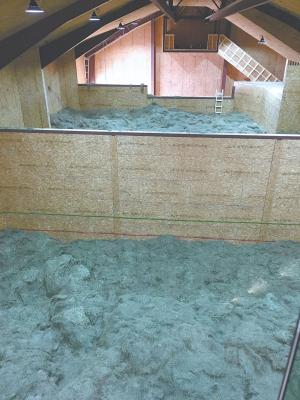Loose Hay Drying System Produces “Best” Quality Bales
Intense humidity and not enough rain-free days in succession make it difficult to put up quality hay in Ontario, says Lars Steunebrink. So, instead of counting on Mother Nature, hay for his dairy goats dries inside a specially designed building with Austrian hay-drying equipment.
He and his wife, Ingrid, started their goat dairy in 2016, and quality hay was a priority for animal health and higher milk production.
“We didn’t want silage that can mold and cause listeria. And we want longevity out of our goats and less trouble with health issues,” Steunebrink says. After traveling to Germany and talking to producers, he purchased the hay-drying system.
Instead of leaving cut hay on the fields for 4 or 5 days to dry, it’s picked up after just a day or two at about 35 percent moisture with a self-loading wagon and hauled to the couple’s 10,800-sq. ft. building, of which more than half is used as drying space. The wagon is pulled into the drive-through at one end of the building. Hay is picked up with a grapple mounted on a crane with a cab for the operator that travels on rails in the shed’s roof. The hay is dropped into one of two drying boxes with wire mesh floors.
The building is designed to bring air from the top through a dehumidifier with two registers. The first cools the air to remove moisture. The heat taken from the air goes to the second register to be put back into the air that was just dried to create warm, dry air that goes through a fan blowing under the hay.
Hay can be stacked out of the field (wet) to about 20 ft. and dries in 3 to 5 days. If necessary, it can be loosened up with the grapple. The two boxes total about 6,240 sq. ft. Steunebrink cuts all of his 225 acres of hay in May for his first cutting. After that is dried and baled out of the box, he has room for future cuttings. Bales are stored in a separate building.
There’s enough room in the drying boxes to hold all the hay from the following 3 or 4 cuttings. Between cuttings, dry hay is removed with the grapple to use as feed dropped in a forage box, or baled to store or sell.
Steunebrink has made small bales, but prefers 3 by 4-ft. bales for ease of handling. Most of the time, the goats are fed loose hay right from the boxes.
“The hay you get is as bright as you can imagine. It’s green as grass. We can’t make that around here, especially not with young nutrient-rich grass. For us it’s a huge quality difference,” Steunebrink says. “Plus, I can feed less grain.”
Operational cost is 1/2-cent/lb. of hay for electricity. The initial cost was substantial, but Steunebrink notes they were starting from scratch and setting up silage bunks is costly, too.
“This is easier to work with,” he says, noting he gets the hay from inside, not outside from a cold, snowy bunk. “I’ve been more than happy with it.”
Besides working well with grass hay for his 1,200 dairy goat operation, he adds that the drying system works well for alfalfa and alfalfa mixes. Besides hay the system works for drying hops and herbs.
Steunebrink is so impressed with the system that he became the North American distributor for the company. He invites people to contact him for more information.
Contact: FARM SHOW Followup, Lars Steunebrink, 42540 Huron St., Kirkton, Ont. Canada N0K 1K0 (ph 519 274-4370; larssteunebrink@hotmail.com).

Click here to download page story appeared in.
Click here to read entire issue
Loose Hay Drying System Produces “Best” Quality Bales BALE HANDLING Intense humidity and not enough rain-free days in succession make it difficult to put up quality hay in Ontario says Lars Steunebrink So instead of counting on Mother Nature hay for his dairy goats dries inside a specially designed building with Austrian hay-drying equipment He and his wife Ingrid started their goat dairy in 2016 and quality hay was a priority for animal health and higher milk production “We didn’t want silage that can mold and cause listeria And we want longevity out of our goats and less trouble with health issues ” Steunebrink says After traveling to Germany and talking to producers he purchased the hay-drying system Instead of leaving cut hay on the fields for 4 or 5 days to dry it’s picked up after just a day or two at about 35 percent moisture with a self-loading wagon and hauled to the couple’s 10 800-sq ft building of which more than half is used as drying space The wagon is pulled into the drive-through at one end of the building Hay is picked up with a grapple mounted on a crane with a cab for the operator that travels on rails in the shed’s roof The hay is dropped into one of two drying boxes with wire mesh floors The building is designed to bring air from the top through a dehumidifier with two registers The first cools the air to remove moisture The heat taken from the air goes to the second register to be put back into the air that was just dried to create warm dry air that goes through a fan blowing under the hay Hay can be stacked out of the field wet to about 20 ft and dries in 3 to 5 days If necessary it can be loosened up with the grapple The two boxes total about 6 240 sq ft Steunebrink cuts all of his 225 acres of hay in May for his first cutting After that is dried and baled out of the box he has room for future cuttings Bales are stored in a separate building There’s enough room in the drying boxes to hold all the hay from the following 3 or 4 cuttings Between cuttings dry hay is removed with the grapple to use as feed dropped in a forage box or baled to store or sell Steunebrink has made small bales but prefers 3 by 4-ft bales for ease of handling Most of the time the goats are fed loose hay right from the boxes “The hay you get is as bright as you can imagine It’s green as grass We can’t make that around here especially not with young nutrient-rich grass For us it’s a huge quality difference ” Steunebrink says “Plus I can feed less grain ” Operational cost is 1/2-cent/lb of hay for electricity The initial cost was substantial but Steunebrink notes they were starting from scratch and setting up silage bunks is costly too “This is easier to work with ” he says noting he gets the hay from inside not outside from a cold snowy bunk “I’ve been more than happy with it ” Besides working well with grass hay for his 1 200 dairy goat operation he adds that the drying system works well for alfalfa and alfalfa mixes Besides hay the system works for drying hops and herbs Steunebrink is so impressed with the system that he became the North American distributor for the company He invites people to contact him for more information Contact: FARM SHOW Followup Lars Steunebrink 42540 Huron St Kirkton Ont Canada N0K 1K0 ph 519 274-4370; larssteunebrink@hotmail com
To read the rest of this story, download this issue below or click
here to register with your account number.









